Our St Andrews Connection
My grandfather David Cargill was born in St Andrews in 1874.
This is surprising since the Cargills are from Auchmithie and Arbroath. What were they doing in St Andrews?
Four brothers and their families all left Auchmithie and settled in St Andrews. They were William Cargill (aged 35), Robert (32) (my great grandfather), Alexander (28) and David (20). William, Robert & Alexander arrived in St Andrews in 1873 and were joined by the newly-married David in 1874/5. They seem to have settled well in St Andrews as they all had 2 or 3 children there. However, by 1881, they had all moved again, this time to Arbroath.
In the 1870s, quite a few Auchmithie families left for Crail and St Monans in Fife. Also, there were quite a few families and individuals who moved to Arbroath.
Auchmithie was not an easy place to work. There was no harbour at this time, so beaching and launching were difficult. The houses were on the cliff-top, so a steep climb with the catch, and a trail down with the lines and nets.
The attractions of Arbroath and other ports with harbours and no cliffs are obvious. Around this time, boats were larger and fishing distances were greater, 50 miles rather than 15 miles, and therefore fishermen were visiting other ports and seeing their advantages.
However, the reason might simply have been the availability of accommodation. Were there too many families for the houses available in Auchmithie? Was accommodation in Arbroath also limited at that time? They certainly found houses at Shorehead in St Andrews.
These pictures show the contrast between Auchmithie and St Andrews. Auchmithie is high above its shore while St Andrews has a harbour at town level. A great deal of effort was required to launch and beach the boats at Auchmithie.
The Auchmithie pictures are probably from around 1900.
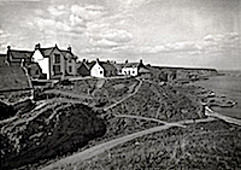
Auchmithie Village & Cliffs
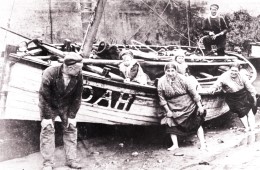
Launching (posed, I think)
©Angus District Council
These pictures from around 1890 show St Andrews Harbour and Shorehead with the Bell Rock Tavern on the right/east and St Andrews Cathedral behind.

Shorehead, St Andrews.
About 1890. ©RCAHMS
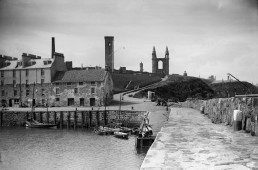
Shorehead, St Andrews.
About 1890. ©RCAHMS
Copies are obtainable from the Royal Commission on the Ancient and Historical Monuments of Scotland website, the Canmore section.
We know nothing of their lives in St Andrews, except for the tragedy in 1875. William died when he was washed overboard from the 'Ann Wishart' in heavy seas when trying to enter the harbour at St Andrews in October 1875.
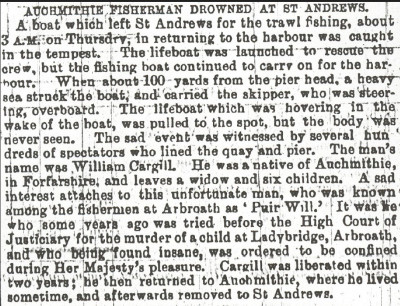
In my first attempt at recording these events, I speculated that the reason for the move was the crime committed by William in Arbroath; see below. I thought that only his brother Robert was with him in St Andrews and that on William's death, Robert moved to Arbroath.
My second attempt postulated that it was simply all about housing. More research has provided a fuller answer. The following contemporary account focuses on the death of William and also provides some insights into other factors that caused both the move to St Andrews and the move 7 years later to Arbroath. This extract is from a book titled "Wrecks and Reminiscences of St Andrews Bay" by George Bruce published in 1884, just a few years after the Cargills departed for Arbroath.
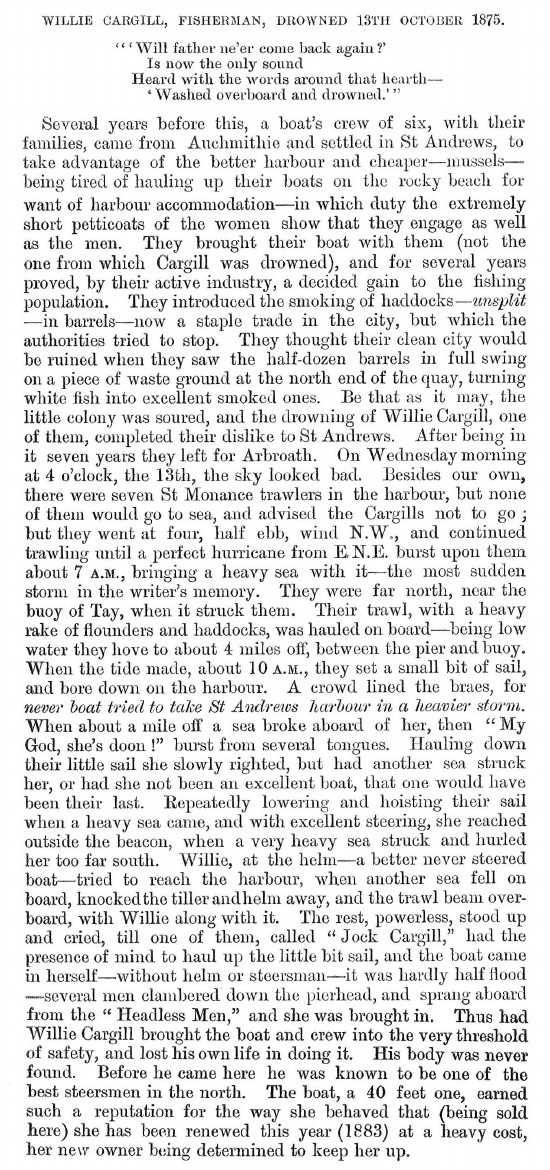
It seems from this narrative that William's history was not a factor and William's story does not really belong here; his crime did not cause the move to St Andrews. But it could have been a contributory factor. Perhaps he found it difficult to rejoin Auchmithie village life and perhaps the villagers were wary and frightened of him.
William's story :-
It seems that William was not good at school, not being able to read and write, unlike his siblings and he was known in the village as Puir Will. When older, he became religious and is reported, on one occasion, as having called the whole village to church early one morning. His religion was of a fundamentalist type - hell and damnation for sinners. He was smart enough to be the skipper (owner/part owner?) of a fishing boat, and terrified his crew on at least one occasion with his sermonising and visions; he was forced to sell out after that episode.
Shortly after selling his boat, and after the church incident in Auchmithie, he was fishing from Arbroath, and lodging there with his wife and children. This was in 1868. They were staying in Ladybridge Street, near the harbour and it was here that he murdered a child.
He admitted the murder and was found not guilty because of his insanity and was then detained in Perth Prison for about 2 years.
The murdered child and William were distantly related. She was the daughter of David Swankie and Helen Stewart. Helen's sister Isabel was married to James Cargill, who was William's oldest brother.
I do not know what caused William's problems. It seems that he had a couple of serious epileptic fits in his late 20s which seemed to affect him badly. He could have been dyslexic, hence his poor schooling. Other comments about him include the possibility that he was bi-polar or suffered from schizophrenia or alcoholism or religious mania. The newspaper reports of his trial only tell us that he was insane when he committed the crime. There is no mention of him being treated for a problem.
His being unable to read and write does suggest a problem such as dyslexia. And the fact that he eventually became the skipper of a fishing boat does suggest that his childhood nickname of Puir Will was a misnomer. But he probably had a tough childhood because of his disability and then he managed, for a time, to rise above his problems. But something cracked and he murdered the wee girl; a tragedy for both of them.
However, his family stood by him and he and his brothers shared the adventure and difficulties of moving to St Andrews. But, sadly for William, it ended in tragedy.
Here are links to further details of the case :-
The Scotsman - Ann Swankie Murder
The Arbroath Guide - Ann Swankie Murder N.B. This is a very LARGE file.